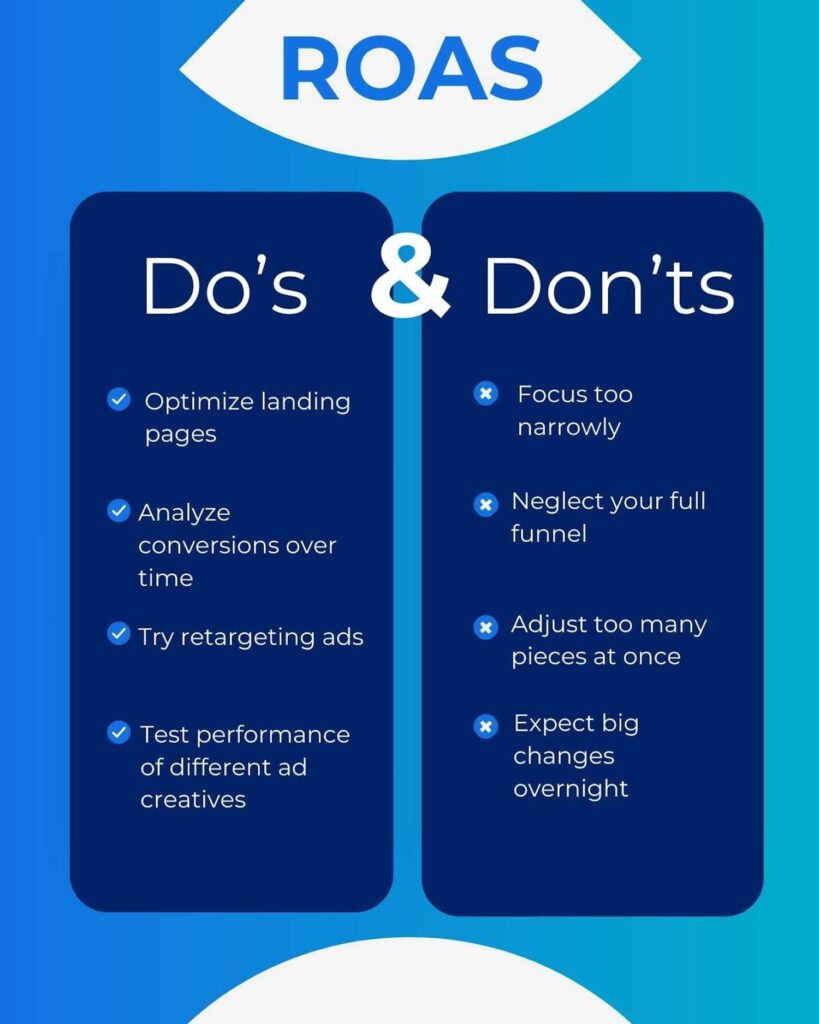Last updated on February 12th, 2025 at 08:03 am
What makes a marketing campaign successful? At the most basic level, you want your campaigns to bring in more money than they cost. Understanding your return on ad spend (ROAS) is key to assessing performance and guiding marketing decisions.
This post will break down exactly what this metric means and why it’s essential to your business. We’ll debunk the one-size-fits-all “good” ROAS across businesses and industries, Advanced you’ll get actionable tips to improve your return and avoid common pitfalls. Whether you’re new to digital advertising or improving on existing efforts, you’ll find straightforward advice to inform your approach. Let’s unlock the full potential of your ad spend!
Defining ROAS
Firstly, let’s look at the basics. Your return on ad spend refers to how much revenue your business earns for each dollar spent on advertising.
The formula is pretty simple: ROAS = Revenue Generated / Cost of Advertising. For example, if your campaign brings in $5,000 in sales revenue and costs $1,000 to run, your ROAS is 5 ($5,000 revenue / $1,000 ad spend). For each $1 you spent on ads, you generated $5 in return.
This measure shows how profitable your campaign is and guides where to put your marketing money moving forward. A high ROAS means your ads are good at making sales. Conversely, a low or negative calculation shows your ads don’t make enough money to cover their cost. Watching this over time gives you important info about how well your campaign works.
If the number goes down, you might need to look again at who you’re targeting, what you’re saying, or how creative your ads are.

The Importance of ROAS
Why should you care about calculating and tracking ROAS? There are two big reasons.
1) Evaluate Campaign Effectiveness
ROAS shows you how well your campaigns convert ad spending into revenue. It quantifies the return you’re getting on your marketing investment and acts as a benchmark for performance.
Compare your ROAS over time and across campaigns. This helps you identify your best-performing platforms, ad sets, creatives, landing pages, etc. You can double down on what’s working and cut what’s not giving you enough bang for your buck.
2) Inform Budgeting Decisions
Your ROAS also guides where to allocate the budget moving forward. Want to expand your advertising reach? Only increase spending if you’re seeing healthy ROAS. Lower-than-expected returns signal it’s time to optimize before ramping up spending.
Likewise, an exceptionally high number here indicates untapped potential. It may be profitable to increase your advertising budget if your campaigns efficiently convert extra ad dollars into additional revenue. In short, ROAS helps maximize your marketing ROI. Evaluating it properly lets you make smart financial decisions.
Defining a Healthy ROAS
So, what constitutes a “good” ROAS? The answer depends on your business model, industry benchmarks, and growth objectives. While there are no universal ROAS standards, here are some general guidelines:
- eCommerce: 4+ is generally solid, and anything higher than this would be considered high performance.
- Retail: An ROAS of 3 is the industry benchmark here, though this can also vary based on the market, brand, and product being considered.
- Local Services: Depending on the area and the service, the target here is typically 2-3, but can be even higher.
- B2B: 2-3+ is a positive average metric in this space. Because of the variance in B2B sales processes, this benchmark tends to be on the lower side.
The most important thing is tracking your baseline and looking for improvement over time. Focus less on reaching an arbitrary number and more on incremental gains through testing and optimization.
Set realistic ROAS goals based on past performance and industry averages. As you scale spending, monitor for efficiency drops and adjust targets accordingly. Account for differences across campaigns, segments, and seasons too.
With regular review and experimentation, your “good” ROAS will become clearer over time. The number is unique to your business goals and audience response.
Strategies to Boost Your ROAS
Once you know your current ROAS, focus on incremental improvements through ongoing optimization. Consider implementing some of these proven tips:
- Refine Targeting – Zero in on engaged users most likely to convert rather than looking too broadly. Add exclusions to weed out poor fits.
- Test Ad Creative – Try different copy, formats, placements, and designs. Track performance to double down on what resonates.
- Optimize Landing Pages – Ensure they match your ad messaging and user expectations. Simplify navigation to conversion points.
- Analyze Conversions – Understand your conversion funnel to ID and fix leaks. Track micro-conversions too.
- Study Campaign Data – Check performance by campaign, ad set, keyword, placement, etc. to uncover optimization opportunities.
- Enhance Bidding – Adjust bids based on performance data to balance traffic volume and costs efficiently.
- Integrate Retargeting – Remarket to visitors who didn’t initially convert to re-engage high-intent users.
- Review Frequently – Set aside time each week or month to assess metrics and make changes.
- For lead generation campaigns, review and optimize the sales conversion rates of qualified leads.
With small but methodical tweaks, you gain the experience needed to unlock greater performance over time.

Avoiding Common Pitfalls
When working to improve your ROAS, it’s easy to make missteps that hinder your progress. Be mindful of common mistakes:
- Focusing Too Narrowly – Only analyzing your overall ROAS misses important insights. Dive into the campaign, ad, audience, and other segmented data to uncover optimization opportunities you may be missing.
- Changing Too Much At Once – Modifying multiple elements like targeting, creative, and landing pages simultaneously obscures which changes are driving impact. Take an incremental test-and-learn approach.
- Neglecting the Full Funnel – Look beyond final conversions to identify and address leaks earlier in the customer journey. Are visitors bouncing before reaching checkout or scheduling a service?
- Relying on Defaults – Platform tools provide a starting point but custom strategies tailored to your specific business performance data will outperform defaults. Lean on smart customization.
- Knee-jerk Budget Cuts – Resist the urge to slash spending if ROAS declines temporarily. Methodically test and optimize elements first before scaling back the budget.
- Misplaced Spend – Closely monitor low-converting placements with high traffic – they may be wasting what could be better spent somewhere else.
Tracking and Adjusting ROAS Goals
Finally, continuously track performance to assess campaigns. Use attribution modeling to accurately credit conversions. Break ROAS down by campaign, creative, landing page, audience, etc. to surface optimization opportunities missed in overall numbers.
Equally important, factor in lifetime customer value, not just initial conversions. Consider opportunity costs too – lower ROAS ads may provide needed awareness. Automating dashboards to regularly monitor specific metrics can be helpful, as well.
Revisit goals frequently to consider increasing benchmarks when optimizations improve ROAS, expanding into higher potential segments, or shifting budgets works. Temper expectations if ROAS declines post-quick wins.
Wrapping Up
As we’ve discussed, understanding and tracking ROAS is crucial for evaluating and improving campaign performance over time. When you regularly assess this metric, you gain insight to refine your strategy, increase efficiency, and get the most value from your ad spend.
While it takes time, diligence, and flexibility, all of these small optimizations compound into bigger revenue gains. If you need guidance optimizing your ROAS, Wolfpack Advising is here to help make your ad budget work harder for you – schedule an online consultation today.




